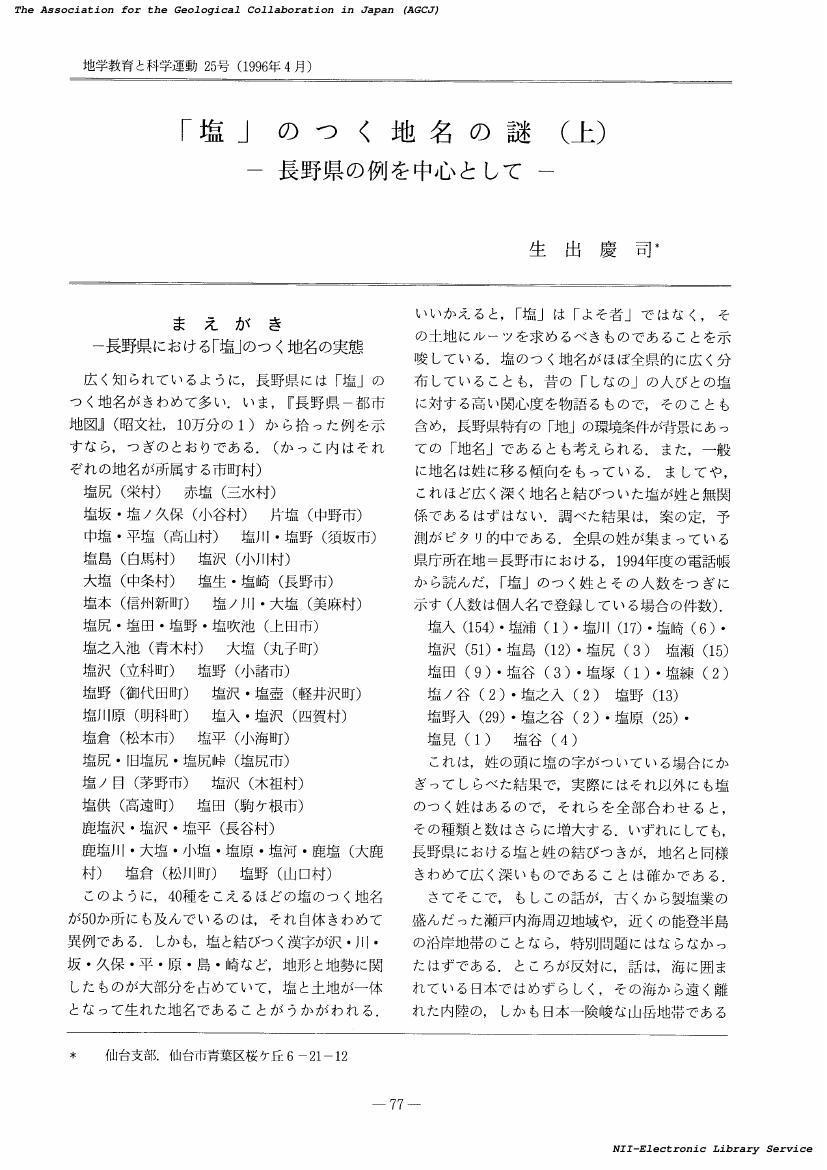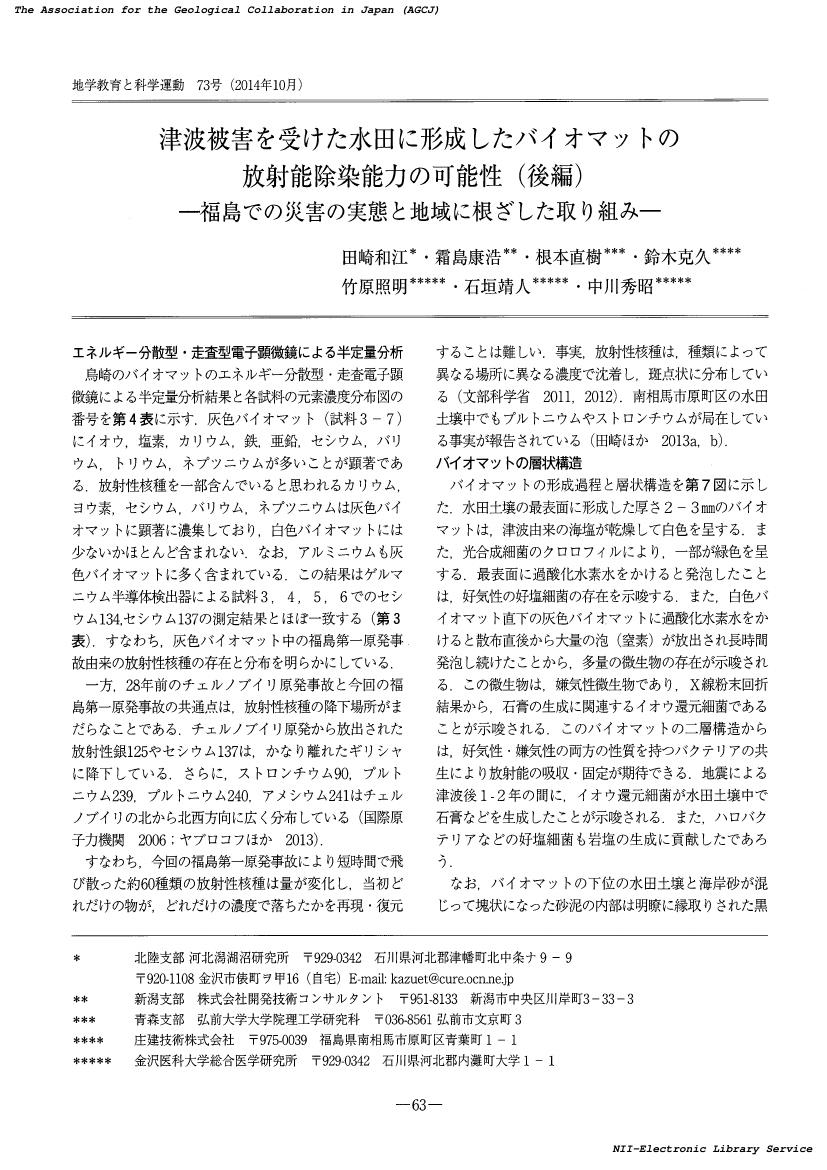9 0 0 0 地球史からみた地球温暖化問題
- 著者
- 秋山 雅彦
- 出版者
- 地学団体研究会
- 雑誌
- 地球科學 (ISSN:03666611)
- 巻号頁・発行日
- vol.58, no.3, pp.139-147, 2004-05-25
- 参考文献数
- 36
- 被引用文献数
- 2
地球大気のCO_2濃度と地球表層の温度との間には密接な関係が存在することから,温暖化はCO_2を排出する化石燃料の燃焼によってもたらされ,地球温暖化対策が国際的な課題として取り上げられてきている.しかし,大気中のCO_2が温室効果に果たす役割は,現在の濃度ですでに飽和になっているため,今後のCO_2濃度の上昇は地球温暖化には影響しない,とする見解も提出されている.しかし,この見解は一般には問題視されていない.もし,この見解が科学的に正しいとするならば,地球温暖化対策は大きく軌道修正を迫られることになる.地質時代における地球大気組成の変遷史を検討すると,確かに,大気中のCO_2濃度と気温との問には密接な関連が浮かび上がってくる.しかし,両者間の原因と結果という因果関係については明らかになっていない.地球温暖化の原因は化石燃料の燃焼である,と断定する前に,太陽活動の変化にともなう気候変動を含め,科学的にその因果関係を解明するための努力がなされなければならない.
9 0 0 0 "和井内遺跡"より出土したパレオパラドキシアの臼歯について
- 著者
- 佐藤 二郎 井尻 正二
- 出版者
- 地学団体研究会
- 雑誌
- 地球科学 (ISSN:03666611)
- 巻号頁・発行日
- vol.31, no.4, pp.149-155, 1977
The purpose of the present article is to describe the mode of occurrence of the molar teeth M3 of Paleoparadoxia tabatai (TOKUNAGA) from "Wainai site" and to consider its archaeological significance. 1) Wainai site is situated on the river terrace at Wainai, Niisato-village, Shimohei-district, Iwate Prefecture, Northeastern Japan. This terrace might be formed at Wurm stage. 2) There are two cultural layers in the terrace deposits at Wainai site. Judging from designs and types of the ceramic tools accompanied, the lower and upper cultural layer may be of the latest Jomon Period and the latest Jomon or the earlist Yayoi Period respectively. Taking into account the circumstances at the time of excavation, it is presumed that the molar teeth were picked up from the lower cultural layer. 3) Among the strata developed in the vicinity of the Wainai site, the Oligocene Kogawa group, especially the Sawamagari formation distributed in Iwaizumi town, Iwate Prefecture is the most probable as the original horizon yield the molar teeth, although it is impossible to make sure the locality of the original fossil. 4) Based on the paleontological and archaeological experiences, the teeth seem to have been collected and processed in order to make the knocknack by the latest Jomon man. If this inference is correct, the teeth are the oldest Desmostylid specimen in Japan collected and processed by the pre-historic humanbeings.
8 0 0 0 OA 地学の科学映画が輝いていた頃 —地団研の科学運動「外史」(3)
- 著者
- 小森 長生
- 出版者
- 地学団体研究会
- 雑誌
- 地学教育と科学運動 (ISSN:03893766)
- 巻号頁・発行日
- vol.91, pp.21-28, 2023 (Released:2023-12-22)
- 参考文献数
- 4
8 0 0 0 OA 「塩」のつく地名の謎(上) : 長野県の例を中心として(開発・災害と地学2)
- 著者
- 生出 慶司
- 出版者
- 地学団体研究会
- 雑誌
- 地学教育と科学運動 (ISSN:03893766)
- 巻号頁・発行日
- vol.25, pp.77-82, 1996-04-25 (Released:2018-03-29)
8 0 0 0 日本産ラブカ科の歯化石とラブカ類の系統と古生態
- 著者
- 後藤 仁敏 サメの歯化石研究会
- 出版者
- 地学団体研究会
- 雑誌
- 地球科學 (ISSN:03666611)
- 巻号頁・発行日
- vol.58, no.6, pp.361-374, 2004-11-25
- 参考文献数
- 48
- 被引用文献数
- 3
現生のラブカChlamydoselachus anguineusは,現生板鰓類のなかで最も原始的な解剖学的特徴を残したサメである.これまでの記録では,ラブカ科の最古の化石は南極のジェームスロス島の白亜紀後期(Campanian)の地層から産出したChlamydoselachus thomsoniであった.本論文では,日本産のラブカ属12本の歯化石にもとづく6種を記載した.すなわち,白亜紀後期(Turonian〜Maastrichtian)の地層から5種(10標本),第三紀中新世の地層から1種(2標本)である.Chlamydoselachus sp. 1の小型の歯は北海道三笠市の上部蝦夷層群(Turonian-Coniacian)と,夕張市鹿島の上部蝦夷層群(Santonian)から産出した.Chlamydoselachus sp. 2の小型の歯とChlamydoselachus sp. 3の大型の歯は,熊本県天草郡竜ケ岳町の姫浦層群樋之島層(Santonian)から産出した.Chlamydoselachus sp. 4の大型の歯とChlamydoselachus sp. 5の超大型の歯は大阪府貝塚市と泉南市昭和池の和泉層群畦ノ谷層(Maastrichtian)から産出した.Chlamydoselachus bracheriの歯は,群馬県富岡市の富岡層群井戸沢層(前期中新世)と同県安中市の富岡層群原田篠層(中期中新世)から産出した.また,ラブカ類の系統発生的関係と古環境の変化について考察した.すなわち,白亜紀後期には大型から小型のラブカ類が浅い海に生息していたのに,中新世になると比較的深い海に中型以下のラブカが棲むようになったことが推定される.
7 0 0 0 OA 寺田寅彦の日本神話解釈について
- 著者
- 宮下 敦
- 出版者
- 地学団体研究会
- 雑誌
- 地学教育と科学運動 (ISSN:03893766)
- 巻号頁・発行日
- vol.91, pp.29-32, 2023 (Released:2023-12-22)
- 参考文献数
- 12
7 0 0 0 天皇海山列 ―発見・命名のいきさつと生成の謎―(紹介)
- 著者
- 杉山 明
- 出版者
- 地学団体研究会
- 雑誌
- 地球科学 (ISSN:03666611)
- 巻号頁・発行日
- vol.59, no.1, pp.72-79, 2005
- 参考文献数
- 21
7 0 0 0 単層の解析 : その実際と堆積学的意義について
- 著者
- 平山 次郎 鈴木 尉元
- 出版者
- 地学団体研究会
- 雑誌
- 地球科學 (ISSN:03666611)
- 巻号頁・発行日
- vol.22, no.2, pp.43-62b, 1968-03-25
A sedimentological study was made of the Flysch-type alternations of Otadai formation, Kazusa group deposited in the central part of the Boso peninsula in upper Pliocene epoch (Fig. 2). The formation consists of rhythmic alternation of sandstone and mudstone and the relative amounts of the two rocks vary in places. Each layer is correlated for more than 30 km in extent, as it has their own characteristics in thickness, texture, composition and colour and is arranged in similar manner at the neighbouring sections (Fig. 3, 4). Several key beds of tuff are the most important in the correlation because of their distinct features. The shape, textural distribution and grain size variation in the layers has been definitely shown by the method stated above. The thicker each layer of sandstone is, the more spacial extent it acquires in general. The layer over 10 cm in thickness at the thickest part reaches more than 30 km in extent. It is asymmetrical in shape owing to the more rapid decrease toward west (Fig. 6). On the other hand, the thickness of mudstone layers increases gradually toward west within the studied area but seems to decrease very rapidly westward (Fig. 5). It is concluded that the thickness variation of sandstone and mudstone assembly is determined by sandstone, that is, the layers of sandstone are very sensitive to the subsidence of the basin. Of course, the subsidence is the neccessary condition for the formation of layers. A layer consists of lamina which are units of mass movement of grains, as will be seen from the Photo. 1. A relatively thick sandstone layer is divided into three intervals based on the nature of lamina, namely, massive graded, parallel-laminated and cross-laminated intervals from the base respectively. But a thin sandstone layer is devoid of massive graded interval and/or parallel-laminated intervals. The arrangement of these lamina is closely related to the thickness variation of a layer (Fig. 6). The grain size distribution and consituents in a layer are also related to the textural arrangement as well as the shape (Fig. 9). The boundaries of textures are nearly parallel to the isometrical lines of median diameter of grain size and sorting coefficient. Shell fragments are concentrated at the bottom of the graded interval, while pumice and plant fragments are often seen in the parallel and cross-laminated intervals. The grain size variation in the mudstone layer seems to be more monotonous and the mean size and sand grain content gradually decrease toward west. As will be known from the fact stated above, sandstone layers are very different from mudstone layers in many respects. And it is observed that the sandstone layer is formed by different way from the mudstone. The inference is substanciated by the difference of faunal assemblages found in both layers. The sandstone has the shell fragments and worn-out foraminifers which are found in the upper neritic zone in the recent environment, while molluscan shells and foraminifers contained in the mudstone are similar to the fauna living in the bottom over 400 m in depth in the Pacific off the Boso peninsula. This fact indicates that sand deposited temporarily under the bottom of shallow sea is transported into the bathyal environment where mud is usually deposited. The direction of current transporting sand grains should be from west to east as is assumed from the sole markings developed under the bottom of sandstone layers and cross laminations (Fig. 10). The nature of flow is inferred from the result of laboratory experiments and observations of alluvial channels. It is controlled by many variables such as depth, slope, size and shape of grains, viscosity and density of sediment-water mixture, etc. So the concept of flow regime (SIMONS & RICHARDSON, 1961) is very useful as it allows grouping of the combined effects of those factors. The classification of flow regime is based on form of the bed configuration, mode of sediment transport, process of energy dissipation and phase relation between the bed and water surface (Fig. 11). According to these elements, it is divided into lower and upper flow regimes (Fig. 11). In the lower flow regime, lamina which are horizontal or inclined 10 degrees or less down stream are well developed, while lamina is not distinct in the upper regime since amount of sediment transported by the flow increases and is not sorted. These changes of lamina might correspond to the textural arragement in a sandstone layer, from the base upward, massive graded, papallel laminated and cross-laminated intervals. It shows that a sandstone layer is formed by a flow which diminishes its energy gradually. Sand mass deposited in the shallow sea collapses just like a landslide and then slides down the slope which is maintained by the subsidence of the basin. It fills the subsiding areas and the relatively flat slope is formed and then mud particles fall down uniformly on it. During the deposition of mud, subsidence of the ground is continued and the depositional areas for sandstone are prepared.
7 0 0 0 OA 南三陸の巨石・奇岩探訪*
- 著者
- 永広 昌之
- 出版者
- 地学団体研究会
- 雑誌
- 地学教育と科学運動 (ISSN:03893766)
- 巻号頁・発行日
- vol.79, pp.24, 2017-11-24 (Released:2020-06-02)
- 参考文献数
- 10
7 0 0 0 函館山からエジル輝石片岩のゼノリスの新産出
- 著者
- 外崎 与之 大竹 伸一
- 出版者
- 地学団体研究会
- 雑誌
- 地球科學 (ISSN:03666611)
- 巻号頁・発行日
- vol.22, no.6, pp.308-309, 1968-11-25
6 0 0 0 OA 大宮台地に分布する硬砂層の性質と堆積環境
- 著者
- 硬砂団体研究グループ
- 出版者
- 地学団体研究会
- 雑誌
- 地球科学 (ISSN:03666611)
- 巻号頁・発行日
- vol.38, no.1, pp.17-30, 1984-01-25 (Released:2017-07-26)
- 被引用文献数
- 1
Katazuna Bed found in a scattered pattern around the Omiya Upland is very indurated as compared with other Quaternary sand deposits. Its stratigraphy and sedimentological properties are examinated and discribed. The results are summerized as followings. 1) Katazuna Bed distributes in slightly high areas in comparison with the surroundness, and occurs in a thin ribbon or pod form with less than 2 m in thickness, 0.7 to 2km in width, and 2 to 5 km in length, and elongated in NNW to SSE. 2) Katazuna Bed covers the tuffaceous sand "Nukazuna Bed" conformably which is deposited under the fresh water conditions and is also covered conformably by upper Shimosueyoshi Loam formation composed of air fall deposits. Katazuna Bed is deposited about the fall stage of "Kuriyokan Pumice" (: KuP.). 3) Katazuna Bed is composed of well sorted sand grains and has white tubular materials composed of alophen clay with 2 or 3 mm in diameter, and may have been indurated by imogolite as cement materials. Based on above-mentioned results, the sedimentary environment of Katazuna Bed is in-ferred as followings. 4) Katazuna Bed is formed as the result of the regression of Paleo-Tokyo Bay and the bed is important as an environmental indicator of the time. We think that in the central part of the Kanto Plain the prevailing winds transported sand grains composing Nukazuna Bed, and formed the Katazuna Bed as small river dunes or thin sand layers.
6 0 0 0 OA 「さざれ石」の由来と地質学的考察(紹介)
- 著者
- 鈴木 博之
- 出版者
- 地学団体研究会
- 雑誌
- 地球科学 (ISSN:03666611)
- 巻号頁・発行日
- vol.57, no.4, pp.243-252, 2003-07-25 (Released:2017-07-14)
6 0 0 0 OA 室生火砕流堆積物の給源火山
- 著者
- 室生団体研究グループ 八尾 昭
- 出版者
- 地学団体研究会
- 雑誌
- 地球科学 (ISSN:03666611)
- 巻号頁・発行日
- vol.62, no.2, pp.97-108, 2008-03-25 (Released:2017-05-16)
- 被引用文献数
- 5
中新世の室生火砕流堆積物は近畿地方,紀伊半島中央部に分布し,その面積は1.9×10^2km^2に達する.室生火砕流堆積物は基底相と主部相に区分できる.基底相は層厚50m未満で異質岩片を含む溶結した火砕流堆積物と火山豆石を含む降下火山灰,火砕サージ堆積物で構成される.主部相はさらに下部にはさまれる層厚30m未満の斜方輝石を含むデイサイト質火山礫凝灰岩と上部の層厚400mを超える膨大な黒雲母流紋岩質火山礫凝灰岩に分けられる.主部相の基質はほとんどが溶結した結晶凝灰岩である.基底相には中礫大未満のチャート,砂岩,頁岩などの岩片が含まれており,室生火砕流堆積物を供給した地域の基盤岩を構成していた.室生火砕流堆積物は以前から中期中新世の熊野・大峯酸性岩類など大規模な珪長質火成岩が分布する南方から供給されたと推定されていた.異質岩片のチャートにペルム紀〜ジュラ紀の放散虫化石が含まれ,その給源火山の一部は秩父帯にあった可能性がある.秩父帯では半円形の断裂に沿って火砕岩岩脈群が貫入する大台コールドロンが存在しており,膨大な火砕流を噴出したことが推定される.
6 0 0 0 OA 東京都江東区越中島地下トンネルガス爆発事故から学ぶ(<特集>環境と地学III)
- 著者
- 中山 俊雄
- 出版者
- 地学団体研究会
- 雑誌
- 地学教育と科学運動 (ISSN:03893766)
- 巻号頁・発行日
- vol.23, pp.27-31, 1994-07-25 (Released:2018-03-29)
6 0 0 0 OA 江戸に降った「毛」 : 江戸(東京)にペレーの毛が降った? その2
- 著者
- 小泉 潔
- 出版者
- 地学団体研究会
- 雑誌
- 地学教育と科学運動 (ISSN:03893766)
- 巻号頁・発行日
- vol.69, pp.89-98, 2013-03-22 (Released:2018-03-29)
- 参考文献数
- 36
- 著者
- 橋本 定樹
- 出版者
- 地学団体研究会
- 雑誌
- 地学教育と科学運動 (ISSN:03893766)
- 巻号頁・発行日
- vol.10, pp.73-80, 1981
6 0 0 0 OA 大阪上町台地南部の上部更新統上町層(フォト)
6 0 0 0 OA 埼玉県秩父地域における東京電力福島第一原発事故による低線量汚染の実態に関する総括的報告
6 0 0 0 長野県上田市の中部中新統から産出した深海性サメ類化石群集
- 著者
- 鈴木 秀史
- 出版者
- 地学団体研究会
- 雑誌
- 地球科學 (ISSN:03666611)
- 巻号頁・発行日
- vol.66, no.2, pp.47-61, 2012-03-25
- 参考文献数
- 75
本論において,中期中新世の横尾層と伊勢山層の泥岩から産出した,深海性サメ類であるツノザメ目3科4属の歯化石を形態的特徴をもとに記載した.これまでの研究と合わせるとツノザメ目5科8属の化石がこの地層から産出したことになる.中新統の地層では,同一の産出地点から同類化石が集中して産出することは極めて珍しい.産状として注目されるのは,最も深い生息域に棲むカラスザメ属,ユメザメ属,フンナガユメザメ属の,生存時に近いと考えられる数本の歯が接合した形で産出したことと,ヨロイザメでは上下顎歯群と皮小歯群が一塊として産出したことである.これらの発見は,サメの接合歯や皮小歯が生存時か死後直後に体から離れ,速やかに泥が被覆し化石化したことを示す.また,これらの化石は中期中新世の北部フォッサマグナ地域の古海況を考察するうえで重要な情報となる.本論により,横尾層上部から伊勢山層下部の地層は,陸棚斜面から深海平原へと連続的に深海化が進んでいったことが明らかとなった.






